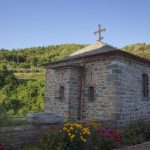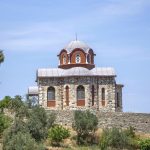The Chapels
Five chapels have survived at the Monastery Karakallou within the complex itself and quite a large number outside of it, in the forest located to the north.
Within the Monastery, the chapel of Sts Panteleimonos and Georgios is located in the bell tower, while five chapels have been built in the wings of the Monastery: St Ioannis the Merciful, St Ioasaf, the Annunciation of the Virgin, the Dormition of the Virgin, and the Great Martyr Gideon.
Across from the entrance to the Monastery, next to the fountain, is the chapel of St Theodoros, while one more chapel dedicated to St Anna is located on the fifth floor of the tower, the structure which also provides entrance to the Monastery.
North of the plane tree of the Monastery, at a short distance from the compound, is the cemetery church, built in 1768 and dedicated to All Saints. It follows the standard, specialized design of a cruciform nave with a blind dome, and an equally wide entrance nave also with a blind dome, which was constructed at the same time as the church.
The church and the entrance nave are decorated with frescoes. One section of the frescoes in the entrance nave has been lost because of work done to reinforce the two arches supporting the dome. The iconographic scheme of the church, despite its relatively limited space, includes a basic cycle of nine scenes from the life of Christ.
The Marian sequence is limited to the Dormition of the Virgin, while in the centre of the eastern arch there is a depiction of the three-person Holy Trinity. On all the remaining surfaces, there are a large number of individual forms, either on the metope of the four edges of the cruciform base (the 24 witness-martyrs, in medallions), on the arch ring (12 prophets in full figure), and in the lower zone which surrounds the nave (30 saints in full figure).
The entrance nave is dominated by the representation of the Virgin Mary on the dome, surrounded by a zone of six prophets predicting the Incarnation of Christ (Άνωθεν οι Προφήται). Four composers or singers of hymns to the Virgin are depicted on the four spheres, while on the remaining surfaces, 30 commemorative representations of saints are depicted, with special emphasis to those saints who are the main figures in the lower zone of the nave. According to a written inscription by one of the owners which is connected to a depiction of the apostles Peter and Paul above the entrance to the church, it was built ‘primarily’ in the year ΑΨΞΗ΄ (= 1768). The paintings and inscription were made by the same workshop, a fact which confirms that the decoration of the walls took place immediately after the construction of the church.
On the mountainside southwest of the Monastery is the chapel of St Paraskevi, now in ruins. Finally, in the forest to the northwest are the cells of the Three Hierarchs, the Holy Precursor of Christ, St Nicholaos, and the True Cross.
Within the Monastery, the chapel of Sts Panteleimonos and Georgios is located in the bell tower, while five chapels have been built in the wings of the Monastery: St Ioannis the Merciful, St Ioasaf, the Annunciation of the Virgin, the Dormition of the Virgin, and the Great Martyr Gideon.
Across from the entrance to the Monastery, next to the fountain, is the chapel of St Theodoros, while one more chapel dedicated to St Anna is located on the fifth floor of the tower, the structure which also provides entrance to the Monastery.
North of the plane tree of the Monastery, at a short distance from the compound, is the cemetery church, built in 1768 and dedicated to All Saints. It follows the standard, specialized design of a cruciform nave with a blind dome, and an equally wide entrance nave also with a blind dome, which was constructed at the same time as the church.
The church and the entrance nave are decorated with frescoes. One section of the frescoes in the entrance nave has been lost because of work done to reinforce the two arches supporting the dome. The iconographic scheme of the church, despite its relatively limited space, includes a basic cycle of nine scenes from the life of Christ.
The Marian sequence is limited to the Dormition of the Virgin, while in the centre of the eastern arch there is a depiction of the three-person Holy Trinity. On all the remaining surfaces, there are a large number of individual forms, either on the metope of the four edges of the cruciform base (the 24 witness-martyrs, in medallions), on the arch ring (12 prophets in full figure), and in the lower zone which surrounds the nave (30 saints in full figure).
The entrance nave is dominated by the representation of the Virgin Mary on the dome, surrounded by a zone of six prophets predicting the Incarnation of Christ (Άνωθεν οι Προφήται). Four composers or singers of hymns to the Virgin are depicted on the four spheres, while on the remaining surfaces, 30 commemorative representations of saints are depicted, with special emphasis to those saints who are the main figures in the lower zone of the nave. According to a written inscription by one of the owners which is connected to a depiction of the apostles Peter and Paul above the entrance to the church, it was built ‘primarily’ in the year ΑΨΞΗ΄ (= 1768). The paintings and inscription were made by the same workshop, a fact which confirms that the decoration of the walls took place immediately after the construction of the church.
On the mountainside southwest of the Monastery is the chapel of St Paraskevi, now in ruins. Finally, in the forest to the northwest are the cells of the Three Hierarchs, the Holy Precursor of Christ, St Nicholaos, and the True Cross.


